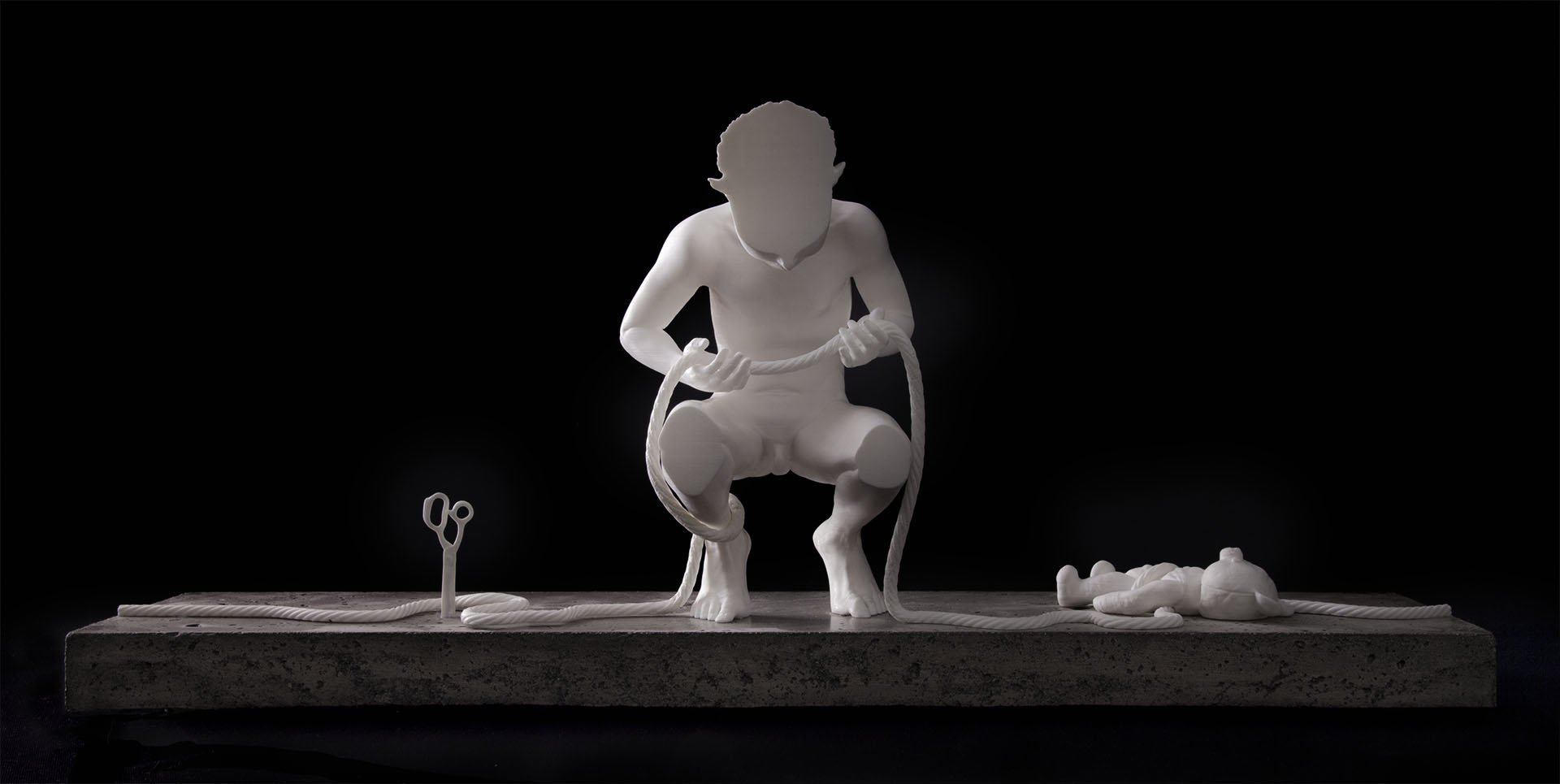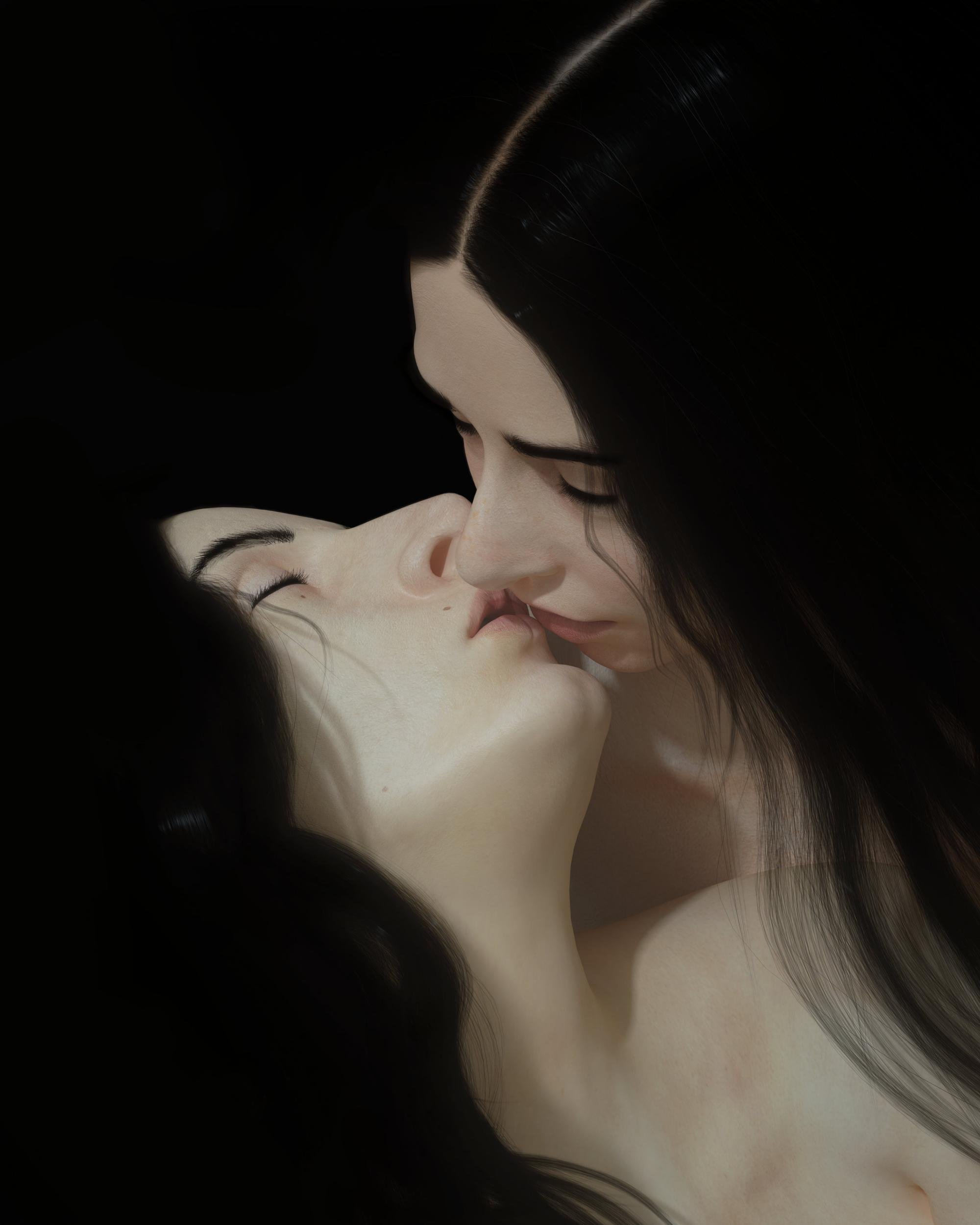Into the Zone with Huleeb

There are artists whose path seems like a road, each work leading to the next in an inevitable succession. Others are like forests. The undergrowth is so dense that you don't know where to look, but if you take the time, you can distinguish individualities, tracks running between the trees. What was once a formless chaos becomes a structured whole, with lines of force running through it. This is precisely the kind of proliferating body of work that Huleeb offers us. Programmer by day and 3D Artist by night, Huleeb has been creating a picture a day for over 4 years. Throughout his journey, he has produced a complex body of work, marked by recurring themes, an instantly recognizable graphic style and a constant exploration of his inner world. Let's take a look at what makes his work so special.
First, you notice the colors, a plain, muted palette. The almost monochrome environments offer a peaceful setting where the eye seems to float in anticipation of change. No wind in the trees, no ripples on the surface of the water. We are here in a space where time has stopped and man has deserted. No one knows where the action takes place. Scottish landscapes rub shoulders with European streets, English forests, industrial zones or American suburbs. These are liminal spaces that always seem to border on other places, literally no-man's-lands, crossed by the presence of man but never inhabited by him. And always that mist that envelops and softens everything.
I like desolate places in fog. I like how it looks mysterious and soft. When using heavy fog, the fog itself becomes an element of the final piece, which is a beautiful way of filling up space.
Huleeb
If these environments are devoid of life, they are nonetheless traversed by other beings, as Huleeb often places one or more characters within his images, immersed in enigmatic activities. The most regular of these visitors is an explorer whose head has been replaced by a hollowed-out cube, a shape that becomes one of the most striking recurrences throughout the images. It's hard not to see here an inverted screen, with the difference that the screen projects something, whereas the ever-present void in the center of this head is more the mark of an aspiration, a transfer of the landscape to the inner self.
I really liked the idea of not having a face at all, kind of inviting the viewer to picture themselves as the character, rather than looking at the facial expression.
Huleeb
It's often this character who brings a touch of brighter color, yellows, oranges or reds that guide the eye inside the image. It seems that color does not emanate from the character, but is provoked by his presence, that his passage is enough to revive the world within the perimeter of his existence. And while the cube-headed figure is often dressed as an explorer or soldier, he appears less to be the driving force behind his journey than an experimenter in the zone's possibilities.
For it is indeed a Zone that Huleeb offers us to see here. As in Tarkovsky's Stalker, with which it shares the same chromatic range and desolate character, Huleeb's Zone acts as a revelator, a subversive agent on the aspirations and soul of the being who crosses it. But unlike the original Zone, which granted a single wish, Huleeb's seems to offer an infinite number of possibilities. The character wanders, fights, falls in love, rides a motorcycle, fishes, cooks, hangs out his washing, without any activity seeming to satisfy him, without ever stopping this incessant display of experiences. Here, he is the receptacle and motor of his desires, sometimes childish or absurd, but whose repetition becomes terrifying. Where is the limit of the Zone? At what point does the character stop running? Is there a purpose to this frenzy of places and actions, or is the character just a tourist, enjoying every moment without really being present at any of them? This impression is heightened by the numerous pictures depicting the character alone, immersed in his thoughts in the midst of an environment that suddenly becomes oppressive. What emerges from this journey is the infinite solitude of the man we're following. Within an ever-changing space, offering an answer to each of his desires, Huleeb's character seems to ask us why we live our lives, why we need to multiply our experiences when none of them satisfies us, when color and taste are absent.
Although I do not feel lonely, solitude is something that looks beautiful in pictures. It creates this feeling of uncertainty and fear, which I do not like, but love to recreate in my fake worlds.
Huleeb
From a stylistic point of view, another highlight is the way in which the material is treated. Huleeb's images are brimming with detail, but detail that paradoxically goes unnoticed, blending into the fog as if everything were made of the same material. Here, it's less a question of highlighting a textural quality than of forming a coherent whole. In the manner of a painter depicting a tree with a few deft brushstrokes, Huleeb shows vegetation, water or stone in broad flat tints that are enhanced by the character, breaking the monotonous ornamentation of the compositions. It's less vegetation than the idea of vegetation, less a building than its essence. This monotony of material, which contrasts with the incredible diversity of the scenes depicted, is further reinforced by the often wide framing. Huleeb's vision is all-encompassing, totalizing. And this vision does not come from nowhere, but is the continuation of a long artistic tradition.
There's the saying; Less is more, a quote by the architect Ludwig Mies van der Rohe.
Huleeb
One of the fundamental characteristics of Huleeb's images is their indecisive nature. They are deeply pictorial and illustrative, yet at the same time pure 3D products. Sometimes they take on the codes of photography, sometimes those of paintings. Past and future are blended into a blurred, malleable and uncertain present. One can't help but think of the works of Simon Stålenhag and Yuri Shwedoff, two artists showing a representation very close to the Zone I mentioned above, but also of the Pictorialists, with the idea that impression takes precedence over precision, that the rigorous exactitude of rendering must be counterbalanced by a more sensitive approach, allowing us to bridge the gaps and fill them with our own interpretations. But what seems closest to Huleeb's approach is perhaps Chirico's Pittura metafisica, with its visions of a deserted, dreamlike world. Chirico wanted to make paintings “that could not be seen”, whose subject was precisely what was not shown. This way of making the invisible visible, of depicting one thing while showing us another, is not only achieved by Huleeb in each of his images, but is also the common thread running through his work. Each thing is never just itself, but what emanates from it, a thing never shown but always evoked. And that thing is silence.
The artist's activity is the creating or establishing of silence
Susan Sontag, Esthetic of Silence
There's no stronger theme in Huleeb than the silence that pervades everything, a diffuse silence, the kind you might find in a landscape shrouded in fog, or in a deserted industrial zone at night. The fact that these characters have no mouths with which to speak - or, more accurately, to scream - makes this silence all the more pervasive. As with Chirico, the landscapes are to be understood not as physical spaces, but as mental ones, allegories of a certain despair and absurdity of life. Each image is a world unto itself, but one that contains the seeds of all the others, just as a tree is a forest unto itself. In Huleeb's work, silence reverberates from image to image, until it becomes deafening, until it becomes a cry. And this cry never seems to stop.
Thanks to Huleeb for taking the time to answer my questions.
You can follow his work on Behance, Instagram or on his website.























